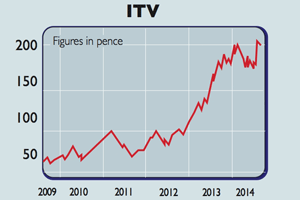Find CEOs with the X factor
If you want to buy stocks that will do well, the numbers are secondary, says Jonathan Compton. The key is to find the star CEOs.

If you want to buy stocks that will do well, the numbers are secondary,says Jonathan Compton. The key is to find the star CEOs.
Here are two simple questions about joint-stock companies (those in which you can buy and sell shares): "what is the purpose of a bank?" and "what is the purpose of an airline?" Typical answers might include: "to look after deposits", "to make loans", or "to fly people safely from one destination to another". All of these answers are wrong.
The purpose of joint-stock companies is to make their shareholders money. That's been the case since they were created ina href the 16th century, and it's why they've been the bedrock of capitalism ever since. Failure to recognise this is down to confusion between the purpose of a company, and how it operates.
Subscribe to MoneyWeek
Subscribe to MoneyWeek today and get your first six magazine issues absolutely FREE

Sign up to Money Morning
Don't miss the latest investment and personal finances news, market analysis, plus money-saving tips with our free twice-daily newsletter
Don't miss the latest investment and personal finances news, market analysis, plus money-saving tips with our free twice-daily newsletter
As joint-stock companies have become ever more widely traded, an industry has grown up alongside them, devoted to trying to pick the best ones to invest in. City analysts spend their careers hunting for the holy grail of what makes a good company.
They focus on the product, profit margins and growth. But most analysts pay no more than lip service to the single most important factor in the equation: management competence.
Trading floors are littered with the corpses of great businesses destroyed by bad management, while many terrible businesses have been resurrected bygood managers. So why do analystspay management so little attention?
It may be because investment banks fear losing corporate business, or dread litigation (many bad managers are notoriously litigious and vindictive); or they may simply prefer lazy, mechanistic spreadsheet analysis over thoughtful research.
Bad management destroys companies
Whatever the reason, you need look no further than the UK to see how awful management has destroyed several global businesses, despite significant competitive advantages. The standout is the motor industry. After World War II, most of Europe's factories had been destroyed.
Other than North America, no one else had any large-scale production. In 1950, the UK produced 785,000 motor vehicles making Britain the second-biggest manufacturer in the world. By 1970, that had risen to 2.1 million units. Car manufacturing was one of the largest stockmarket sectors, with a huge impact throughout the economy.
Yet over this period profitability collapsed, leading to a series of forced mergers. By the end of the 20-year period, a sector that had once had six major players and around 25 smaller ones had shrunk to just a handful of firms.
In 1968 the government effectively forced the merger of the last two the reasonably successful Leyland-Triumph-Rover, and the struggling BMH to form Europe's fourth-largest car maker, British Leyland Motor Corporation. After lurching from crisis to crisis, and selling its better brands to foreigners (who made them work), it was finally put down in 2005.
The absence today of any meaningful British-owned car manufacturer is due almost entirely to bad management. Overlarge boards were stuffed with apparatchiks. Production lines were inefficient, marketing worse and design terrible. Managers blamed the trade unions as a smokescreen for their own incompetence.
Proof of this can be seen in the way the UK has steadily recovered its place as a centre of car manufacturing excellence, once the new foreign owners had dispensed with previous management. There has been a gradual renaissance in production, from a low of 1.2 million units in 1985, to an estimated 1.9 million this year, with forecasts of record production by 2016.
Why car manufacturing attracted bad management remains an enigma. But it wasn't unique to Britain. The same happened a few years later in America. There, the big three (Chrysler, Ford and General Motors) embarked on an equally prolonged suicide mission, producing terrible cars at huge cost, which they couldn't even give away.
Reliability collapsed, consumer preferences were ignored and in practice there were no cost controls. As in the UK, American management blamed the unions, even though labour costs typically accounted for less than 12% of the price of a new car.
The big three saw their market share shrink from 77% in 1984 to 43% in 2010 as foreigners, especially from Japan, moved in. Yet, even as first the British and then the American auto industries rotted away, neither governments, financiers, or shareholders grasped that the core problem was hopeless boards and hapless management.
How do you rate management?
The most widely used measure for rating a company is its long-term return on equity (ROE). This measures how much profit a company generates on the amount that shareholders have invested. So a company with £100m of shareholders' equity, generating a profit of £5m, has made an ROE of 5%.
You have to put this figure into context by looking at the returns to be made by investing elsewhere. If a company is offering a return that is only slightly higher than the yield on government bonds or bank accounts, say, or a return that is lower than its cost of borrowing, then it is making a poor return relative to the risks involved, and in fact is probably destroying shareholders' capital.
You also have to look at whether or not the ROE is higher than the sector average. ROE can also vary widely, depending on what stage of the business cycle the sector is in, so long-term averages are a better guide.
At a national level, ROE shows which countries have higher returns, implying better management ie, those who are best at sweating capital to maximise shareholder returns. In developed countries, the US comes out top consistently, with an average ROE of around 14% a year over the last 15 years. The UK is modestly behind, but with greater annual variations. By contrast, Italy and Japan have averaged less than 7%.
As for industry sectors, the best and worst are similar wherever they're based. The top quartile, at over 15% ROE, always includes tobacco, alcohol, house building and computer services. At the bottom are food processors, pulp and paper, semiconductors and shipbuilding.
Yet, ROE has its flaws shareholder-driven managers seeking to boost ROE have forced many companies into short-term cost-cutting and other measures that detract from their longer-term growth prospects. A broader measure is the return on capital employed (ROCE).
This includes not just shareholder funds, but also all debt and other financing (and so stops managers from pulling the wool over shareholders' eyes by using borrowed money to boost returns). This approach takes profits after tax (but before interest and dividends) as a percentage of total capital.
Again, the winners over 15 years are the US and the UK with a stable average of about 15%, with Germany close behind. Japan scores badly again at around 4%, while the trends in countries such as Italy and France are dire falling from 14% to 6%. Sector returns are similar too.
These theories may give an idea ofthe countries and sectors to focus on. But a critical issue is missing for anyone looking for individual companies to invest in. The cult of the star chief executive (CEO) is replacing board control and consensus management.
So, investors need to know whether or not these CEOs understand that their role is to maximise the return on capital. They also need to look at CEOs' track records: can they set and achieve sensible targets? And can they adapt to changing circumstances and provide direction?
The good, the bad and the ugly
When Steve Jobs was luring a senior executive from PepsiCo to join him at Apple Inc., his sole question was: "Do you want to sell sugar water for the rest of your life, or do you want to come with me and change the world?" A man with focus. After his death in 2011 there were many deserved plaudits for his business skills, but few for his cuddliness. He was ruthless, vicious and obsessive (vowing to spend every cent made to kill Android).
After co-founding Apple, he left in 1985 after a power struggle with the board but became successful elsewhere. By 1996, Apple was teetering into bankruptcy. Jobs returned, first as an adviser, then interim CEO, before taking total control.
Apple became a huge success. Jobs was notoriously impatient with over-analysis of short-term numbers, focusing on price, efficiency, design and (unlike car companies) what people actually wanted.In stark contrast is General Electric a once-great company now in decline.
In September 2001, Jeff Immelt succeeded corporate titan Jack Welch as CEO. The share price was $41. Thirteen years later it is $26 (having been as low as $13) vastly underperforming the S&P 500. Immelt was a good manager and popular.
He has put up two reasonable defences: during his term, GE has paid out over $90bn in dividends and has been subject to unusually strong headwinds. But he has been unable to address the key issues: GE is too large, with too many disparate businesses, too many layers of management, and a lack of focus.
Almost as impressive as Jobs are those CEOs who make a success of firms that have no discernible purpose, or which need to tear up their old business models. An outstanding example is Kate Swann, who ran WH Smith (in which I own shares) from 2003 until early this year.
WH Smith was a moribund business selling nothing special, for which there was no discernible need. Although Swann had a proven track record in retail, few expected big changes when she took over.
The share price says it all it rose from £2.40 when she joined, to above £11 by the time she left. That's not including substantial and rising dividends, and a spin-off to shareholders, which has also been profitable.
But reinvention isn't always easy. One Scandinavian firm is a textbook study of how a series of good CEOs can turn a business inside out several times, sell off its largest divisions to focus brilliantly on the unknown, then get it spectacularly wrong: Nokia.
By 1990, after 100 years of steady but modest success including in pulp and paper, cables and rubber boots Nokia had sold off all these units to focus on its minor electronics division. It was a huge success at one point, Nokia mobile phones commanded a global market share of over 40%.
But the firm had a consensual management style that led to groupthink and inaction. The inability of both the board and its CEOs to recognise the speed of change in an industry that they had helped create saw the share price fall from €56 in 2000 to €6. Now it no longer makes mobiles.
An even worse example is Japan's Sony. It had been a leader in sound for 30 years, generating radios, tape recorders, TVs, film and communications, as well as the ubiquitous Walkman. Unusually for Japan, its co-founder and CEO, Akio Morita, was a production engineer.
But his retirement in 1994 signalled Sony's slow demise, hastened by its inability to adapt from mechanical to digital sound. Its share price has fallen from 17,000 to 1,700 over the last 14 years.
These examples are not unusual. If you want to find good companies to invest in, a focus on what they do and sell, and financial analysis of ratios and returns, is often secondary. The key is to analyse the track record, ability and focus of either the CEO or the board.
If you fail to do so as an investor, then you are walking through a minefield, backwards. I've listed four stocks I believe benefit from good management below.
Four well-managed investments
The four companies recommended are all in different sectors and businesses, but each, to survive, let alone grow, has had to remain flexible. Moreover, each has either a CEO or a management team with a clear vision of how the business should be positioned, supported either by proven track records or by attractive returns on equity and capital employed.

From 2000 to 2009, ITV (LSE: ITV) was an outstanding destroyer of shareholder funds, directionless and floundering. As a result, its share price fell from £2.50 to 19p over the period. It will always be financially weak compared to the better-funded BBC and Sky, while the rising number of channels and new ways to view media are a constant threat.
Through cost controls, better programming and flexibility, the largely new management team, dating from 2008/2009, has simply turned the company around. The five-year ROE is 35% versus 19% for the sector.
WPP (LSE: WPP) once made wire shopping baskets, but morphed into an advertising firm after Martin Sorrell bought a controlling stake in 1985 and became CEO.
He sometimes appears in the press for the wrong reason (the size of his pay package), but for years he's navigated WPP through the shark-infested waters of media and advertising, expanding through acquisition and organic growth to become one of the top four advertising players globally.
Returns and profitability are consistently superior to the sector and most competitors. Given Sorrell is now 69, the prime risk here is one of succession.
One of the peculiarities of the automobile business is thateven though most manufacturers have struggled to makedecent profits, parts suppliers have always made better margins. Even so, as the British car industry committedsuicide, it took down many component makers with it. Thus the very survival of GKN (LSE: GKN) is impressive, all the more so as its origins date back to 1759.
It has continuously adapted to a changing industrial landscape and is now a global component maker not just for the car industry, but also for the higher-margin aerospace industry. Other divisions include metallurgy and power management.
On the downside, profitability must always remain cyclical. However, GKN's management has consistently produced a better ROCE than its peers and has been quick to restructure any division where returns have been too low.
My final pick is the gambling company William Hill (LSE: WMH). The sector suffers from continuous government meddling,irrational changes in tax rules and few barriers to entry.
International expansion is also fraught with substantial risk, as several online gaming companies discovered to their horror in America. William Hill was relatively slow to recognise the permanent change that the internet has made to all gambling and which will slowly make the old betting shop redundant.
This mistake may have been because the company has an unusual record of appointing lifelong employees as senior managers. However, long-serving executives also have aplus point: once policy is agreed, it is then implemented consistently.
Hence the recent results showed nearly 40%of revenue was from online betting, while international expansion (William Hill is now present in nine countries)means dependency on the UK is diminishing. Five-year operating margins are significantly better than the industry,and on a multiple of 13 times and a yield of 3.5%, William Hill offers good value.
Jonathan Compton was until recently MD at Bedlam Asset Management and has spent 30 years in fund management, stockbroking and corporate finance.
Jonathan Compton was MD at Bedlam Asset Management and has spent 30 years in fund management, stockbroking and corporate finance.
-
 British Airways revamps Avios scheme bringing down flight prices to £1
British Airways revamps Avios scheme bringing down flight prices to £1With the new Avios part-payments scheme you can now bag a British Airways flight for as little as £1
By Oojal Dhanjal Published
-
 RBS to close a fifth of branches
RBS to close a fifth of branchesRoyal Bank of Scotland plans to shut 18 branches across Scotland, resulting in the loss of 105 jobs. We have the full list of closures.
By Ruth Emery Published
-
 Invest in space: the final frontier for investors
Invest in space: the final frontier for investorsCover Story Matthew Partridge takes a look at how to invest in space, and explores the top stocks to buy to build exposure to this rapidly expanding sector.
By Dr Matthew Partridge Published
-
 Invest in Brazil as the country gets set for growth
Invest in Brazil as the country gets set for growthCover Story It’s time to invest in Brazil as the economic powerhouse looks set to profit from the two key trends of the next 20 years: the global energy transition and population growth, says James McKeigue.
By James McKeigue Published
-
 5 of the world’s best stocks
5 of the world’s best stocksCover Story Here are five of the world’s best stocks according to Rupert Hargreaves. He believes all of these businesses have unique advantages that will help them grow.
By Rupert Hargreaves Published
-
 The best British tech stocks from a thriving sector
The best British tech stocks from a thriving sectorCover Story Move over, Silicon Valley. Over the past two decades the UK has become one of the main global hubs for tech start-ups. Matthew Partridge explains why, and highlights the most promising investments.
By Dr Matthew Partridge Published
-
 Could gold be the basis for a new global currency?
Could gold be the basis for a new global currency?Cover Story Gold has always been the most reliable form of money. Now collaboration between China and Russia could lead to a new gold-backed means of exchange – giving prices a big boost, says Dominic Frisby
By Dominic Frisby Published
-
 How to invest in videogames – a Great British success story
How to invest in videogames – a Great British success storyCover Story The pandemic gave the videogame sector a big boost, and that strong growth will endure. Bruce Packard provides an overview of the global outlook and assesses the four key UK-listed gaming firms.
By Bruce Packard Published
-
 How to invest in smart factories as the “fourth industrial revolution” arrives
How to invest in smart factories as the “fourth industrial revolution” arrivesCover Story Exciting new technologies and trends are coming together to change the face of manufacturing. Matthew Partridge looks at the companies that will drive the fourth industrial revolution.
By Dr Matthew Partridge Published
-
 Why now is a good time to buy diamond miners
Why now is a good time to buy diamond minersCover Story Demand for the gems is set to outstrip supply, making it a good time to buy miners, says David J. Stevenson.
By David J Stevenson Last updated